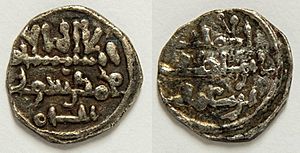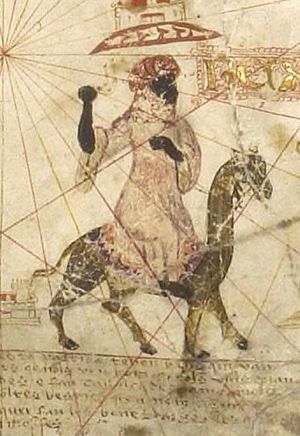Abu Bakr ibn Umar facts for kids
Quick facts for kids أبو بكر بن عمرAbu Bakr ibn Umar |
|||||
|---|---|---|---|---|---|
| Amir Al-Muslimin | |||||

Coin minted under Abu Bakr ibn Umar
|
|||||
| Amir of the Almoravids | |||||
| Reign | 1056 – 1087 | ||||
| Successor | Yusuf ibn Tashfin | ||||
| Partitioned rule | 1072 – 1087 | ||||
| Co-ruler | Yusuf ibn Tashfin (1072 - 1087) | ||||
| Born | Unknown | ||||
| Died | 1087 Tagant |
||||
| Spouse | Zaynab an-Nafzawiyyah (m. 1068; div. 1071) Fâtimata Sal (c.1086) |
||||
| Issue | Amadou ben Boubakar | ||||
|
|||||
| Father | Umar ben Ibrahim al-Lamtuni | ||||
| Mother | Safiya al-Djedaliya | ||||
| Religion | Islam | ||||
Abu Bakr ibn Umar (died 1087) was an important leader of the Almoravids. He was an Emir (a type of ruler or prince) from 1056 until his death. People remember him for founding the famous Moroccan city of Marrakesh. He also helped spread the religion of Islam in parts of Western Sub-Saharan Africa. Abu Bakr died in 1087, possibly from a poisoned arrow in Senegal.
Contents
Life of Abu Bakr ibn Umar
Abu Bakr ibn Umar was part of the Lamtuna Berber tribe. His brother, Yahya ibn Umar al-Lamtuni, was a leader who, with a religious teacher named Abdallah ibn Yasin, started the Almoravid movement around 1050.
Becoming Almoravid Leader
When his brother Yahya died in 1056, Abdallah ibn Yasin chose Abu Bakr to be the new military commander of the Almoravids. That same year, Abu Bakr took back the city of Sijilmassa. This city was very important for trade.
To keep Sijilmassa safe, Abu Bakr led his army to control the roads and valleys in southern Morocco. He gained support from other tribes and conquered the Sous valley. In 1057, he captured the city of Taroudannt.
Expanding the Almoravid Empire
The Almoravids then moved into the High Atlas mountains. They took control of Aghmat in 1058. Sadly, their religious leader, Abdallah ibn Yasin, was killed while exploring new lands. Abu Bakr quickly led his army to get revenge and conquered the area where Abdallah was killed.
After Abdallah ibn Yasin's death, Abu Bakr became the sole leader. He took the title amir al-Muslimin, which means "Prince of the Muslims." This showed he was a strong leader but not a religious ruler like a caliph.
Founding Marrakesh
Abu Bakr married Zaynab an-Nafzawiyyah, a very rich woman from Aghmat. She helped him understand the politics of the region. However, Abu Bakr was a desert warrior and found city life too busy.
Around 1060, Abu Bakr and his men left Aghmat. They set up their camp near the Tensift River. Over time, this camp grew into the city of Marrakesh. It was a unique city, designed to feel like a desert oasis with palm trees.
Sharing Power with Yusuf ibn Tashfin
Abu Bakr put his cousin, Yusuf ibn Tashfin, in charge of Aghmat. Yusuf was tasked with fighting against other tribes to the north. While Abu Bakr stayed in Marrakesh, Yusuf led the Almoravid armies. They conquered many northern areas, and in 1070, they captured Fez, an important Moroccan city.
Some of the desert tribes were unhappy with these long and costly campaigns. Abu Bakr decided to go back to the Sahara desert to calm things down. He left Yusuf ibn Tashfin in charge of Morocco. Before he left, Abu Bakr divorced Zaynab, telling her to marry Yusuf if she needed protection. This was a common practice among their tribe before long journeys.
Later Life and Death
When Abu Bakr returned to Morocco in 1072, Yusuf ibn Tashfin did not want to give up his power. Yusuf, encouraged by his new wife Zaynab, met with Abu Bakr. They agreed that Yusuf would rule the northern lands. As a sign of respect, Yusuf kept Abu Bakr's name on the Almoravid coins until Abu Bakr died.
Abu Bakr went back to the Sahara to lead the southern part of the Almoravid empire. He started new campaigns against the Ghana Empire in 1076. He is known for helping to spread Islam in the areas south of the Sahara desert, even reaching as far as Mali and Gao.
Abu Bakr ibn Umar died in 1087. After his death, his lands were divided among his sons and nephews. Some stories say he was killed by a poisoned arrow during a fight in Mauritania. Other stories from the Wolof say a Serer archer killed him near a lake in Senegal.
See also
 In Spanish: Abu Bakr Ibn Umar para niños
In Spanish: Abu Bakr Ibn Umar para niños
- Islamic empires
- Serer people
Sources
- Ibn Idhari, Al-bayan al-mughrib Part III, annotated Spanish translation by A. Huici Miranda, Valencia, 1963.
- N. Levtzion & J.F.P. Hopkins, Corpus of early Arabic sources for West African history, Cambridge University Press, 1981, ISBN: 0-521-22422-5 (reprint: Markus Wiener, Princeton, 2000, ISBN: 1-55876-241-8). Contains English translations of extracts from medieval works dealing with the Almoravids; the selections cover some (but not all) of the information above.
| Preceded by Yahya ibn Umar and Abdallah ibn Yasin |
Almoravid (in the early days with Abdallah ibn Yasin) 1056–1087 |
Succeeded by Yusuf ibn Tashfin |


